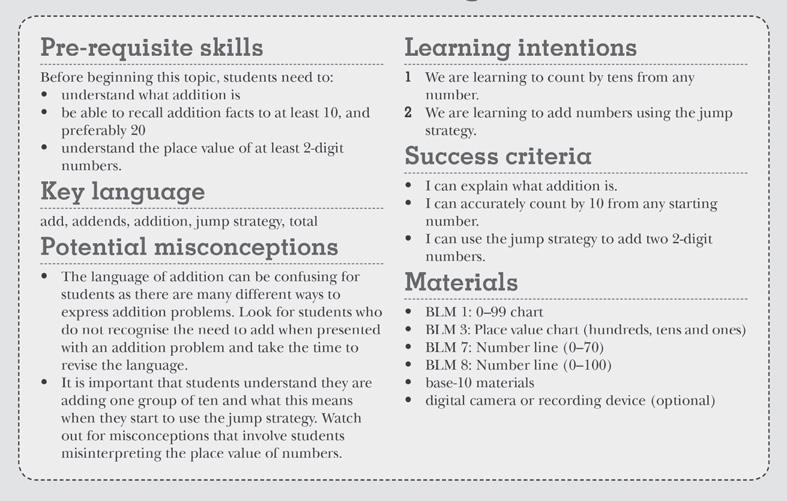
4 minute read
Using Oxford Maths Ready
The Oxford Maths Ready Teacher Handbook is organised to give teachers a sequential plan to approach each topic. The content allows teachers to rst build students’ understanding of the language required as a foundation from which to develop their knowledge of the underlying concepts and skills. It is recognised, however, that every class and context is different, and teachers should feel free to adapt the sequence and activities based on their knowledge of the individuals that they are teaching.
Pre-requisite skills The ‘Pre-requisite skills’ section lists the basic mathematical skills and concepts (usually aligned to the year level below, as outlined in the Australian Curriculum) that students will need in order to access the content of the topic. If students have not yet attained these skills, you can refer to Oxford Maths Ready for the previous year level for ideas on how to develop them. Key language The ‘Key language’ section lists the important words and phrases that are covered in the topic. Students will have an opportunity to develop their understanding of this language through the activities in the ‘Explore the language’ section. Potential misconceptions The ‘Potential misconceptions’ section gives teachers a snapshot of some of the areas that students might SAMPLE be having dif culty with in relation to the topic at hand. It provides information about how to recognise when students may have a misconception so that you can focus on this during their learning. A suite of videos are available online at oxfordowl.com.au. These videos provide further support for teachers as students develop their knowledge of a topic and may encounter potential dif culties related to that topic.
Learning intentions
The ‘Learning intentions’ section uses student-friendly language to state the skills and/or concepts that the topic aims to develop. Setting and communicating learning intentions and success criteria have been found to improve student outcomes by helping learners understand the purpose and expectations of what they are engaged in. It is suggested that the learning intentions are revisited throughout the learning activities.
Success criteria
The ‘Success criteria’ section gives teachers and students some simple measures to identify whether the learning intentions have been achieved. It’s important to note that the success criteria are not meant to be limiting but they do make learning visible for students. Success can look different for different students and the measures identi ed in this book may need to be tailored for individual students.
The materials required for all lessons and activities for each topic are listed to allow teachers to prepare in advance. It is assumed that everyday classroom resources such as paper and pencils are readily available.
BLMs
All BLMs are available online at oxfordowl.com.au. A thumbnail of each BLM has been provided at the back of this book for reference.
Priming for knowledge
‘Priming for knowledge’ aims to build con dence and improve outcomes for students who are struggling. It involves giving them a leg-up in terms of preparing them for learning before the whole class is exposed to a topic. Oxford Maths Ready uses two main strategies to achieve this: activating students’ prior knowledge and developing their facility with mathematical language.
Activate prior knowledge
‘Activating prior knowledge’ involves reminding students what they already know about a topic to build their con dence and help them to meaningfully connect with new learning. The activities in this section not only help students draw on their existing knowledge and personal experiences but also provide teachers with additional information about what students currently know about a topic. Explore the language Mathematical language can be complex and confusing for students. There are many words we use in maths that have different meanings in other areas of life, and there are many technical terms that we assume students understand. This section scaffolds explicit discussion of the key language required for a topic, supporting students to build an understanding of the terminology before they start exploring a topic in more depth. Consolidating knowledge and skills Practice is vital if students are to retain their mathematics learning over time (Sigmundsson, Polman, & Lorås, 2013). Through exploration and application, students are able to re ne and embed their learning. Teachers then need to be able to quickly identify how successful the instruction has been for students. Exploration The ‘Exploration’ section shows how to involve students in teacher-led activities that develop knowledge of two key concepts relevant to the topic. Activities are hands-on, often collaborative, and provide opportunities for students to discuss their understanding. Application The ‘Application’ section provides activities that are connected with the same two central concepts that students SAMPLE have explored. These activities allow students to apply their knowledge in a more independent way. The activities also facilitate ongoing formative assessment of students’ understandings of the topic, while giving students the opportunity to put what they have learned into practice.
Checking for understanding
The ‘Checking for understanding’ section provides a short ‘snapshot’ activity that will allow teachers to quickly gauge whether students have understood the concepts. It also gives further ideas and guidance if students are still having dif culty.

